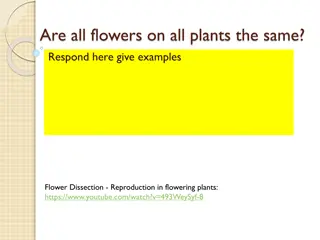Exploring the World of Plants: An Overview
Plants play a vital role in sustaining life on Earth by producing food and oxygen. This comprehensive guide delves into the diverse types of plants, such as herbs, shrubs, trees, creepers, and climbers. It also discusses the essential components of plants, like leaves, transpiration, and photosynthesis, shedding light on their importance in the ecosystem.
Download Presentation

Please find below an Image/Link to download the presentation.
The content on the website is provided AS IS for your information and personal use only. It may not be sold, licensed, or shared on other websites without obtaining consent from the author.If you encounter any issues during the download, it is possible that the publisher has removed the file from their server.
You are allowed to download the files provided on this website for personal or commercial use, subject to the condition that they are used lawfully. All files are the property of their respective owners.
The content on the website is provided AS IS for your information and personal use only. It may not be sold, licensed, or shared on other websites without obtaining consent from the author.
E N D
Presentation Transcript
StudyMafia.Org Getting to Know Plants Submitted To: Submitted By: Studymafia.org Studymafia.org
Table Contents Definition Introduction Getting To Know Plants Conclusion 2
Definition Plants are all around us. They help sustain life on earth by creating food and giving out oxygen that we breathe in. 3
Getting To Know Plants Plants Plants are the immovable living organisms all around us. They are the primary food providers. They are mostly green in colour and use sun as the source of energy to make food. 5
Getting To Know Plants Herbs, shrubs and trees Herbs are the smallest plants and do not have woody stem. Shrubs are slightly larger than herbs. Trees are the largest plants and can have large and thick woody stem. 6
Getting To Know Plants Creepers and climbers Creepers and Climbers are types of plants, which need support to grow. Algae and mosses Algae and mosses are the most primitive or simple plants. Algae are found mostly floating on water and mosses are seen on surfaces, rocks or bark of trees in humid conditions. 7
Getting To Know Plants Leaf Leaf is the most important part of the plant. Most leaves of plants are green in colour. There are different shapes and sizes of leaves. Different parts of a leaf, Leaf has different parts: the midrib the veins the leaf blade/lamina 8
Getting To Know Plants Transpiration Transpiration is the loss of water from aerial parts of the plant, especially from leaves. Water is lost in the form of water vapours through tiny openings called stomata, present on the underside of leaves. 10
Getting To Know Plants Photosynthesis Photosynthesis is the process by which the plant converts carbon dioxide and water into food using sunlight as the energy source. Photosynthesis happens in green leaves. 11
Getting To Know Plants Root Root is the part of the plant that is found under the soil. It provides stability to the plant and also absorbs water and minerals. Types of roots There are two types of roots; tap root and fibrous root. Tap roots are seen in large trees and shrubs. Fibrous roots are common in herbs. 12
Getting To Know Plants Stem Stem is the main part of the plant. It gives the structural support and helps in transportation of the water, minerals and food. The leaves and branches originate from the stem. 13
Getting To Know Plants Flower A flower is the reproductive part of a flowering plant. The only function a flower serves is the reproduction. Different parts of a flower have different functions. 14
Getting To Know Plants Seed A seed is made up different parts. The plumule gives rise to the shoot and the radicle grows into the roots. The cotyledons provide nutrition. Types of seeds There are two types of seeds on the basis of number of cotyledons. Monocots have single cotyledon. Dicots have two cotyledons. 15
Getting To Know Plants Food: fruits and vegetables Fruits are very different from vegetables. Fruits always develop from a flower, while vegetable are parts of the plant that are edible for us, it could be the shoots, the leaves, the roots or even the fruits. Tomato is a classic example of a vegetable as a fruit too. 17
Conclusion Plants are an essential resource - we rely on them for food, water, medicine, the air we breathe, habitat, our climate and more. 18
References Google.com Wikipedia.org Studymafia.org Slidespanda.com
Thanks To StudyMafia.org























